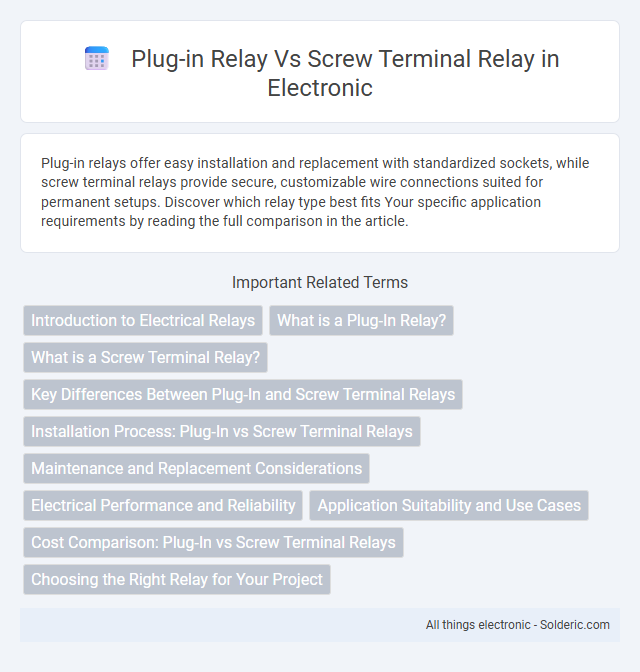Plug-in relays offer easy installation and replacement with standardized sockets, while screw terminal relays provide secure, customizable wire connections suited for permanent setups. Discover which relay type best fits Your specific application requirements by reading the full comparison in the article.
Comparison Table
| Feature | Plug-in Relay | Screw Terminal Relay |
|---|---|---|
| Connection Type | Socket-based, plug-in design for easy replacement | Direct wiring to screw terminals for secure attachment |
| Installation | Quick and tool-free | Requires screwdriver, more time-consuming |
| Maintenance | Simple relay swap without rewiring | Loosen and retighten screws during replacement |
| Durability | Socket contacts may wear with frequent changes | Screw terminals provide robust, stable connection |
| Vibration Resistance | Moderate resistance; depends on socket quality | High vibration resistance due to tight screw grip |
| Cost | Generally more expensive due to socket assemblies | Cost-effective with minimal additional components |
| Typical Applications | Industrial automation, quick relay replacement setups | Permanent installations, high-vibration environments |
Introduction to Electrical Relays
Electrical relays serve as essential switches in circuits, enabling control of high-power devices through low-power signals. Plug-in relays offer easy replacement and secure connections with their socket mounting design, while screw terminal relays emphasize durability and strong mechanical fastening via screw connections. Both types enhance circuit reliability, with plug-in relays favored for maintenance efficiency and screw terminal relays preferred in environments requiring robust, vibration-resistant contacts.
What is a Plug-In Relay?
A Plug-In Relay is an electromechanical switch designed for easy installation and replacement by plugging directly into a compatible socket, eliminating the need for soldering or complex wiring. It typically features a compact design with multiple pins that connect securely to the socket, providing reliable electrical contact and simplifying maintenance in control panels or automation systems. Your choice of plug-in relay ensures faster troubleshooting and system uptime, especially in applications requiring frequent relay swaps or upgrades.
What is a Screw Terminal Relay?
A screw terminal relay is an electromechanical switching device that uses secure screw terminals for wiring connections, ensuring reliable and robust electrical contacts. This type of relay is favored for its ease of installation, allowing your equipment to maintain solid connectivity in demanding industrial environments. Compared to plug-in relays, screw terminal relays offer enhanced vibration resistance and customization possibilities in wiring configurations.
Key Differences Between Plug-In and Screw Terminal Relays
Plug-in relays offer quick installation and replacement with a socket-based design, while screw terminal relays provide a more secure and stable wiring connection using screw clamps. You benefit from plug-in relays in applications requiring frequent maintenance or swapping, whereas screw terminal relays excel in environments demanding robust, vibration-resistant connections. The choice directly impacts your electrical setup's ease of servicing and long-term reliability.
Installation Process: Plug-In vs Screw Terminal Relays
Plug-in relays offer a streamlined installation process with their socket-based design, enabling quick replacement and reduced wiring errors compared to screw terminal relays. Screw terminal relays require manual tightening of terminals, increasing installation time but providing flexibility for custom wiring configurations. The plug-in design is ideal for applications needing frequent relay changes, while screw terminal relays suit permanent or semi-permanent setups requiring robust mechanical connections.
Maintenance and Replacement Considerations
Plug-in relays facilitate quicker maintenance and replacement due to their modular design, allowing easy removal and installation without disturbing wiring. Screw terminal relays require tools and more time for replacement, as each wire must be individually disconnected and re-secured, increasing the risk of wiring errors. Your choice impacts downtime and labor costs, with plug-in relays offering a more efficient option for environments demanding frequent maintenance.
Electrical Performance and Reliability
Plug-in relays offer superior electrical performance through enhanced contact materials and consistent coil voltage ratings, minimizing contact resistance and ensuring stable switching operations under high loads. Screw terminal relays provide reliable connections with robust mechanical fastening, but may experience increased contact degradation over time due to vibration and loosening, which can affect long-term reliability. High-quality plug-in relays typically exhibit better durability in industrial environments, maintaining low signal interference and improved lifespan compared to screw terminal counterparts.
Application Suitability and Use Cases
Plug-in relays offer quick installation and easy replacement, making them ideal for applications requiring frequent maintenance or testing, such as automation systems and control panels. Screw terminal relays provide secure, robust connections suitable for high-vibration environments or permanent installations like industrial machinery and heavy-duty equipment. Your choice between these relay types depends on factors like maintenance frequency, environmental conditions, and the need for reliable, durable connections.
Cost Comparison: Plug-In vs Screw Terminal Relays
Plug-in relays typically offer a higher upfront cost compared to screw terminal relays, primarily due to their modular design and ease of installation. Screw terminal relays are more cost-effective for bulk purchases, favored in applications requiring robust and secure wiring connections without frequent replacement. Considering total cost of ownership, plug-in relays may reduce labor expenses during maintenance, but screw terminal relays provide long-term savings in environments with stable configurations.
Choosing the Right Relay for Your Project
Selecting the right relay depends on factors like installation convenience and maintenance needs; plug-in relays offer quick socket-based replacement ideal for projects requiring frequent relay swaps, while screw terminal relays provide secure, vibration-resistant connections suitable for permanent or high-vibration environments. Plug-in relays reduce wiring complexity and enable faster troubleshooting, making them preferable for modular systems and prototyping. Screw terminal relays ensure strong mechanical stability and can handle higher current loads, making them ideal for heavy-duty industrial applications.
Plug-in relay vs screw terminal relay Infographic

 solderic.com
solderic.com